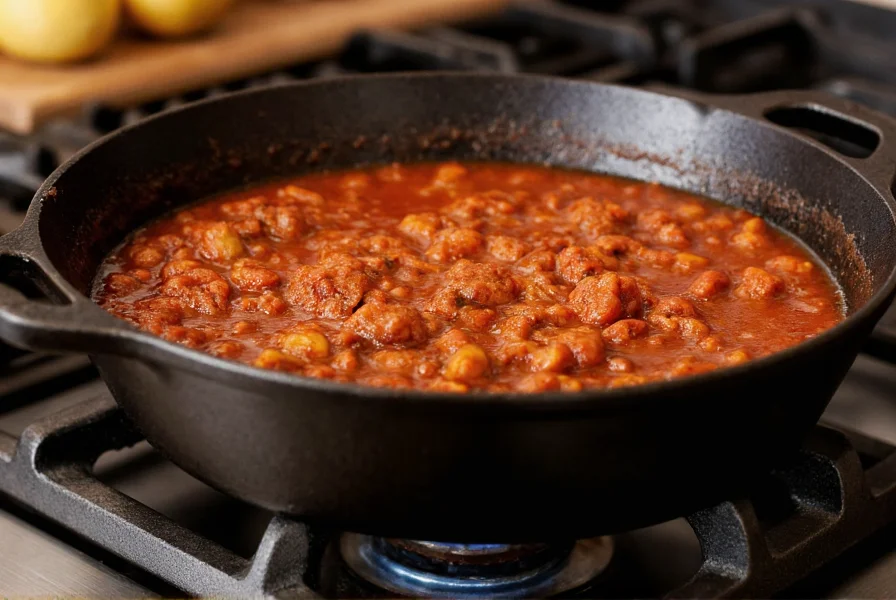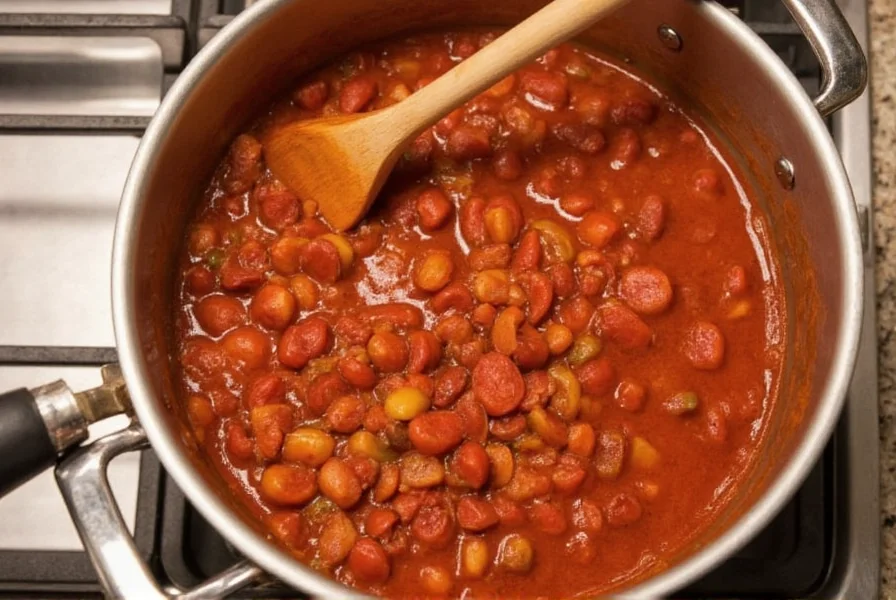When preparing chili on the stovetop, understanding the proper cooking duration is crucial for achieving that perfect balance of flavors and textures. Many home cooks make the mistake of either undercooking their chili, resulting in raw flavors and improperly softened ingredients, or overcooking it until the vegetables disintegrate and the meat becomes dry.
Factors That Determine Chili Cooking Time
The "how long to cook chili on stove" question doesn't have a single universal answer. Several variables affect the ideal simmering duration:
- Type of meat used - Ground beef typically requires less time (60-90 minutes) than tougher cuts like chuck roast (2-3 hours)
- Desired consistency - Thicker chili needs longer simmering to reduce liquid
- Heat level - Low and slow cooking develops better flavor than high-heat rapid cooking
- Additional ingredients - Beans may require less time than meat-only chili
- Recipe complexity - Simple chili vs. complex recipes with multiple spices and ingredients
Step-by-Step Stovetop Chili Cooking Process
Follow this professional approach to achieve perfectly cooked chili every time:
- Preparation (15-20 minutes): Brown your meat thoroughly and sauté vegetables before adding liquids
- Initial Simmer (30 minutes): Bring to a gentle boil, then reduce to low heat for the first 30 minutes
- Main Cooking Phase (60-180 minutes): Maintain a gentle simmer with occasional stirring
- Final Adjustment (15-20 minutes): Taste and adjust seasonings before serving
| Chili Type | Minimum Cooking Time | Optimal Cooking Time | Maximum Recommended Time |
|---|---|---|---|
| Basic Ground Beef Chili | 60 minutes | 90 minutes | 2 hours |
| Chuck Roast or Stew Meat Chili | 90 minutes | 2-3 hours | 4 hours |
| Bean-Heavy Vegetarian Chili | 45 minutes | 60-75 minutes | 90 minutes |
| Turkey or Chicken Chili | 45 minutes | 60 minutes | 90 minutes |
How to Know When Your Chili Is Perfectly Cooked
Don't rely solely on the clock when determining how long should chili simmer on stove. Instead, look for these visual and textural indicators:
- The oil test: When chili is properly cooked, you'll see a thin layer of oil separating and floating on the surface
- Consistency check: Run a spoon across the bottom of the pot - if the line remains visible for a few seconds before filling in, your chili has reached ideal thickness
- Meat texture: For chunk-style chili, meat should be fork-tender but still hold its shape
- Flavor development: The individual ingredients should meld into a complex, unified flavor profile

Common Mistakes That Affect Cooking Time
Understanding how long to cook chili on stove top involves avoiding these frequent errors:
- Boiling instead of simmering: Vigorous boiling causes ingredients to break down too quickly while preventing proper flavor development
- Stirring too frequently: Excessive stirring can break down ingredients prematurely
- Adding cold ingredients late in cooking: This disrupts the cooking process and extends total time needed
- Not allowing for resting time: Chili always improves after sitting for 15-20 minutes off heat before serving
Time-Saving Techniques Without Sacrificing Quality
If you're wondering how long does chili take to cook when you're short on time, try these professional shortcuts:
- Pre-cook meat: Brown meat the night before and refrigerate; reduces active cooking time by 20-30 minutes
- Use quality canned tomatoes: High-end canned tomatoes need less cooking time to develop flavor than fresh
- Add tomato paste: 2 tablespoons of tomato paste added during cooking helps develop depth of flavor more quickly
- Finish with acid: A splash of vinegar or lime juice at the end can make a shorter-cooked chili taste more developed

Advanced Flavor Development Techniques
For those seeking the answer to how long to cook chili for best flavor, consider these professional methods:
- The overnight method: Cook chili for 90 minutes, refrigerate overnight, then reheat gently for 30 minutes before serving (flavors deepen significantly)
- Layered spice addition: Add different spices at different cooking stages for complex flavor development
- Controlled reduction: Remove lid for the final 20-30 minutes to achieve perfect consistency without overcooking
- Finishing ingredients: Add fresh herbs or a small amount of chocolate in the last 10 minutes for flavor enhancement
Special Considerations for Different Chili Styles
The question how long do you cook chili on the stove varies significantly by regional style:
- Texas-style chili: Typically requires 3-4 hours of slow cooking to properly tenderize the meat and develop the rich, meat-forward flavor profile
- Cincinnati-style chili: Benefits from 2 hours of simmering to allow the unique spice blend to permeate the meat
- White chicken chili: Needs only 45-60 minutes as poultry cooks faster than beef
- Vegan chili: Can be ready in 45 minutes, though 60-75 minutes allows flavors to meld better
Storage and Reheating Tips
Properly cooked chili often tastes even better the next day. Store cooled chili in airtight containers for up to 4 days in the refrigerator or freeze for up to 6 months. When reheating, do so gently over medium-low heat, adding a small amount of water or broth if needed to restore ideal consistency.
Frequently Asked Questions
Can you overcook chili on the stove?
Yes, overcooking chili can lead to mushy ingredients, especially beans and vegetables, and can cause the meat to become dry and stringy. While chili generally benefits from longer cooking times for flavor development, most recipes shouldn't exceed 4 hours of simmering. After 3-4 hours, check frequently and consider transferring to a slow cooker on warm setting if you need to keep it hot longer.
Does chili taste better the longer it cooks?
Generally yes, chili flavors improve with longer cooking times up to a point. The first 90 minutes develop basic flavors, while 2-3 hours allows for optimal flavor melding. However, beyond 4 hours, ingredients may break down too much and flavors can become muted. Many chefs recommend cooking chili for 2-3 hours, then letting it rest off heat for 30 minutes before serving for the best balance of texture and flavor.
Should chili be covered or uncovered when simmering?
For most of the cooking time, chili should simmer covered to retain moisture and heat. However, during the final 20-30 minutes, remove the lid to allow excess liquid to evaporate and achieve your desired thickness. If your chili is too thin, simmer uncovered for longer; if it's too thick, add small amounts of broth or water while covered.
How long should chili simmer after adding beans?
When adding canned beans to chili, simmer for 20-30 minutes after incorporation. This allows the beans to absorb flavors without becoming mushy. For dried beans that require pre-cooking, add them earlier in the process (about 60 minutes before finishing) since they need more time to soften properly. Overcooking beans can cause them to break down and make your chili too thick.
Can I cook chili for 8 hours on low heat?
While chili can technically cook for 8 hours on very low heat, it's generally not recommended for stovetop cooking. Extended cooking beyond 4 hours can cause vegetables to disintegrate and meat to become dry. If you need to keep chili hot for extended periods, cook it for 2-3 hours to develop flavors, then transfer to a slow cooker on the 'warm' setting (not 'low') which maintains temperature without continuing to cook the ingredients.











 浙公网安备
33010002000092号
浙公网安备
33010002000092号 浙B2-20120091-4
浙B2-20120091-4